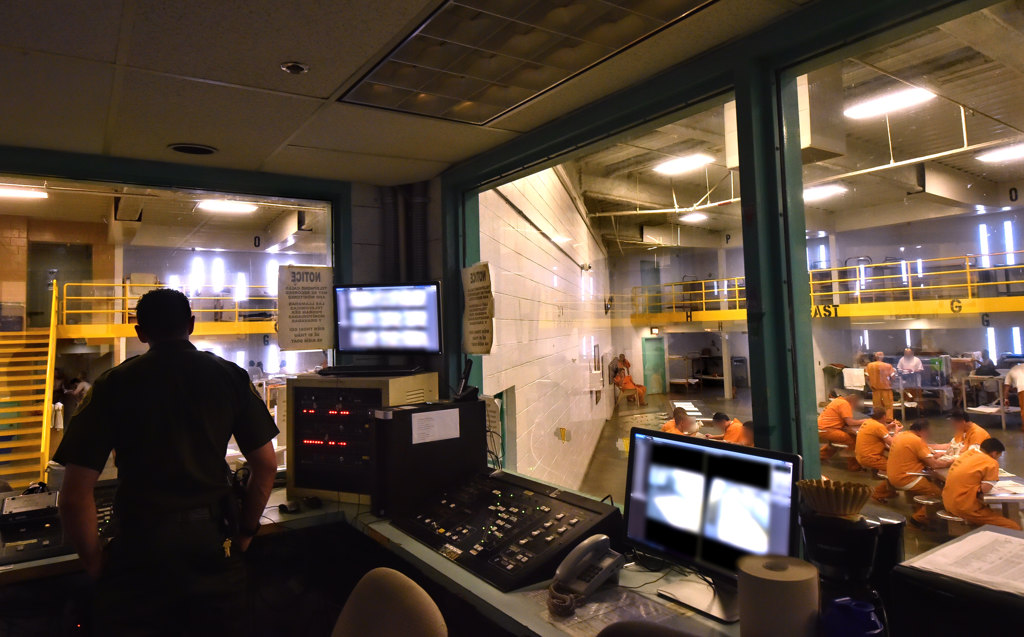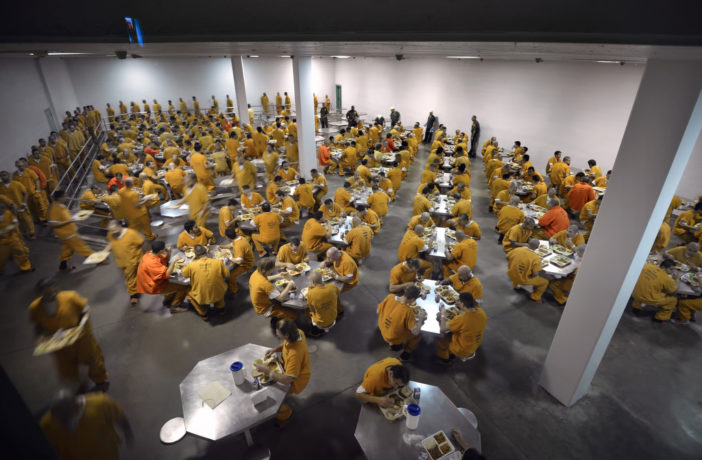The jail riot began a couple hours after 3 p.m. chow time.
Male inmates in a 64-person tank, unhappy with how they believed they should be treated in county jail, started lighting items on fire — mattresses, commissary items, stuff they smuggled in.
The 6 p.m. uprising on Saturday, May 16, 2018 at the Central’s Men’s Jail in Santa Ana ultimately spread to the four tanks that make up the B Module, and then spilled over into the A Module.
Fortunately, say jail officials, no staff members were injured during the two hours it took to quell the riot. Several inmates suffered minor injuries.

In this file photo, Inmates read newspapers and play chess at the Theo Lacy Facility in Orange. File photo by Steven Georges/Behind the Badge OC
But the riot — one of the more serious recent ones in the O.C. jail system, according to top officials — underscored a new reality deputies face daily: a dramatic increase in violence and smuggled contraband, particularly drugs.
O.C. jail officials blame the spike on the passage of AB109, the prison realignment law that went into effect in October 2011 that allowed convicted, so-called non-violent inmates to serve sentences in county jails.
And since that jail riot, there have been other violent incidents directed at deputies and staff members in O.C. jails.
A few days before Christmas 2018, five Central Men’s Jail housing staff members were hospitalized with moderate injuries after numerous inmates carried out an unprovoked attack on them.
The attack occurred while inmates were exchanging clothing and sheets in a hallway in the Central Men’s Jail. The altercation was quickly controlled. One inmate also was also taken to the hospital with moderate injuries.
On Saturday, Jan. 12, 2019, an inmate stabbed a deputy at the Theo Lacy facility. The deputy was with another deputy and a sergeant and they were attempting to address an inmate who did not want to get out of his cell for a disciplinary hearing.
The deputy was stabbed with a piece of metal sharpened to make a weapon. OCSD officials are investigating how the inmate obtained the weapon.
CULTURAL SHIFT
AB109, designed to reduce state prison overcrowding, has created a cultural shift among O.C. inmates, particularly those housed at the Theo Lacy Facility in Orange and in the Central Men’s Jail (CMJ) in Santa Ana, OCSD officials say.
Inmates used to some of the perks found in state prisons — a TV, say, or time in the yard — are demanding the same inside O.C. jails, which were designed for relatively short-term incarceration and aren’t set up, like prisons are, to effectively separate certain populations from others.

Barbed wire lines the walkways of the Theo Lacy Facility in Orange.
File photo by Steven Georges/Behind the Badge OC
Early last year, OCSD worked to implement new strategies and practices to keep O.C. jail facilities safe.
An incident during the riot illustrates the new mindset among many inmates, said Commander Joe Balicki, who oversees custody operations.
“One inmate flat out told a staff member who was interviewing him, ‘You need to treat us like state prisons treat us. This is our tank, and if you want to come in, you need to ask us permission,’” Balicki said.
OCSD Sheriff Don Barnes said it doesn’t feel like they’re running a county jail anymore, but rather a state prison.
“These state-prisoners-turned-county-inmates are more criminally sophisticated, increasing both the amount of contraband inside of Orange County Jails and inmate assaults on staff,” Barnes said. “This challenge is not unique to the Sheriff’s Department, but it’s a dynamic of the jail system that agencies across the state are facing.”

An OCSD deputy keeps watch on inmates at the Theo Lacy Facility in Orange.
File photo by Steven Georges/Behind the Badge OC
STAGGERING STATISTICS
On any given day, there are about 6,000 inmates behind bars at the OCSD’s three facilities – the Central Jail, Theo Lacy, and the Intake Release Center (IRC). (Inmates from the James A. Musick Facility were transitioned to other facilities this month to accommodate a temporary closure of the facility.)
The average O.C. jail population is down compared to several years ago.
But violence is up.
According to the OCSD:
— Pre-AB 109, from 2007 to 2011, there was an average of 26.8 inmate-on-staff assaults per year. From 2012 to 2017, there was an average of 64.5 inmate assaults on staff per year — a 140 percent increase.
— Pre-AB 109, from 2007 to 2011, there was an average of 334 inmate-on-inmate assaults per year. From 2012 to 2017, there was an average of 745 inmate-on- inmate assaults per year — a 123 percent increase.
— Since AB 109 took effect in 2011, there has been a huge increase in drugs and drug contraband inside O.C. jails. From 2008-2011, there were an average of 57 reports per year of drugs in jail. From 2012-2017, that number ballooned to an average of 468 reports per year, with 2017 hitting an all-time high of 738 reports.
— From 2011 to 2016, there was a 131 percent increase in use-of-force incidents
“There has been a paradigm shift and it’s something our personnel are constantly strategizing how best to navigate,” Barnes said. “Every day our deputies are confronted with blatant disregard for jail rules, failure to follow directions and sometimes overt violence against both our personnel and other inmates.”
In one recent incident, a deputy was cold-cocked by an inmate causing problems in a common area as the deputy was trying to put handcuffs on him. As another deputy went after the inmates, the rest of the inmates crowded around.
Luckily, the incident soon was resolved without serious injuries to either the deputies or inmates.
In another incident, inmates were walking by and one of them stepped out of line and assaulted a deputy for no reason.
In yet another recent incident, four Hispanic inmates jumped a black inmate who was being moved from his cell.
The OCSD averages about three to five incidents per day in which a jail deputy has to use force to quell a problem, Balicki said.
“This generation of deputy, or anybody working for a law enforcement agency, has it much, much, much harder than in the past,” Balicki said. “It’s much more of a challenge, and it just seems to be getting worse.”
In addition to the increase in violence, jail deputies face the challenge of trying to stem the flood of illegal drugs — heroin, methamphetamine, cocaine, marijuana, to name some — into jails.
That’s nothing new.
But so-called “flash incarcerations,” a result of AB109, is compounding the problem. Such incarcerations refer to periods of detention between one and 10 consecutive days due to an offender violating conditions of his or her post-release supervision.
When such offenders know they are returning to jail, they’ll try to sneak in drugs – by ingesting them or concealing them in body cavities. In the latter case, deputies need to have probable cause and get a court warrant.
In the first three months of this year, deputies identified 35 people smuggling drugs into the jails and custody canines have alerted to 147 greeting cards soaked in narcotics, with the majority containing methamphetamine.
“Unfortunately some inmates have smuggled in drugs and faced the consequence of illicit drug use—overdose,” Barnes said. “Deputies have saved the lives of multiple inmates who have overdosed on their contraband.”
Several months ago, an inmate smuggled in 17 grams of fentanyl, the opioid that is up to 100 times more potent than morphine and many times that of heroin and can be deadly when simply absorbed through the skin.
Two inmates overdosed, so deputies were given Naloxone to revive them and get them off to the hospital. Naloxone is a nasal spray that counteract the effects of an opioid-induced overdose.
Deputies recovered almost all of the fentanyl, but had to move 130 inmates during the search.
A hazmat crew had to be brought in to decontaminate the area and the affected inmates had to be strip searched and re-clothed.
Most recently, deputies in June saved the life of another inmate who was overdosing.
Deputies immediately worked on the man with no pulse and skin that quickly was turning blue. On-site registered nurses also responded, and after about 15 minutes of CPR, multiple deployments of Naloxone and a shock from an automated external defibrillator (AED), the inmate started breathing. He survived.
That deployment of Naloxone was one of the 28 so far this year – setting the Sheriff’s Department on-pace to more than double the number of doses given out in 2018.
The sharp increase in the prevalence of opioids and other contraband in the jails has officials concerned because when drugs are smuggled in, deputies don’t always know what they’re handling.
“It has us on high-alert,” Barnes said. “Something as potent and dangerous as fentanyl has prompted a total overhaul of our strategies in how we handle jail contraband.”
In yet another challenge, OCSD jail deputies have seen a dramatic rise in the number of inmates with mental health issues.
“We have over 1,800 people that are classified by (Orange County Health Care Agencies’) Behavioral Health Services as having mental health issues,” Balicki said.
That translates to nearly 30 percent of the average daily O.C. jail system population, a percentage that has quadrupled over the last couple of years.
And mentally unstable inmates make for potentially dangerous ones, officials said.
“County jails were never designed to serve as medical facilities to care for those with mental health issues, but we have been proactive in adapting to this new role and have made it a priority,” Barnes said. “We recently designated a unit inside (the IRC) that will house five of our more acute mentally ill, and we’re working toward opening a new facility designated for those with mental health issues.
“We are doing our part to ensure they are receiving some semblance of treatment and are connected with services so when they are released, they aren’t destined to repeat the cycle.”
NEW STRATEGIES
In early 2018, OCSD leaders began implementing new strategies to address the shifting culture among inmates used to doing time in state prisons.
They had to rethink their tactics and strategies in the jails, from how they deploy deputies in mass-movement areas, to forward deploying, and to the use of less-lethal weapons.
“We’ve become more proactive,” Balicki said.
In the past, jail deputies would rush in and try to break up inmate fights.
Since May 2018, deputies have been staying at a distance and using pepper balls, pepper spray, sting-ball grenades and other less-lethal weapons to stop fights and other disturbances.
Deputies are trying to handle such incidents from a distance so they have more control.
Balicki recounted an incident in which about 80 inmates were fighting in a day room area.
“One deputy entered and deployed a sting ball (hard rubber balls that give off a bright flash and loud noise when they explode),” he said. “It was very effective, resulting in no injuries to staff.”
In addition, the number of deputies working inside chow halls and monitoring the movement of a large number of inmates has been increased. And deputies now always work in pairs so they can watch each other’s backs.
The changes are working, Balicki said.
“We’ve seen that even the inmate-on-inmate violence now, as soon as the deputies get in and give commands, minimal deployment of the less-lethal weapons usually stops the problem,” Balicki said. “Now, our injuries to our staff are way down.”
FAIR TREATMENT
Last year, the OCSD released a statement in response to an American Civil Liberties Union protest outside the Central Jail Complex in Santa Ana in support of a planned hunger strike being orchestrated by a convicted murderer and admitted gang member.
“Maintaining the safety and security of our jails is our top priority,” the statement read, in part. “Bad actors, such as prison and street gangs, present a constant challenge to custody management. Gangs attempt to control state prisons and local jails through intimidation, fear, and violence. Their control often times reaches beyond the walls of prisons, directing the criminal activities of street gangs throughout Southern California.
“Jail is a place for confinement of people accused or convicted of a crime,” the statement continued. “Claims of inhumane treatment at Orange County jails are patently inaccurate …. We adhere to state and federal mandates for the care and control of Orange County’s inmates, and are regularly inspected by a variety of external organizations with consistent positive feedback.”
OCSD leaders are striving to improve the safety of O.C. jails not only for deputies, but inmates as well.
“It’s difficult for the public to truly grasp the complexities and challenges we face in running these jails, and I believe we do an exceptional job day in and day out,” Barnes said. “We take very seriously our responsibility for the safety and security of those in our custody and we will never stop innovating to ensure we are doing the best job possible.”
 Behind the Badge
Behind the Badge





